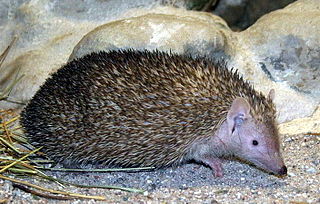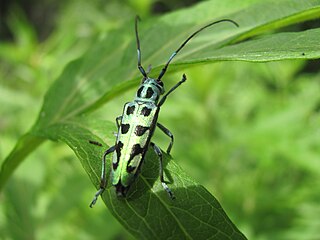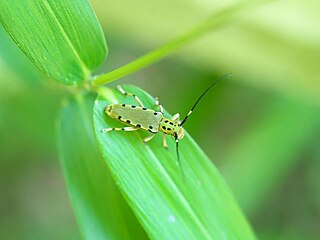
Golden moles are small insectivorous burrowing mammals endemic to Southern Africa. They comprise the family Chrysochloridae and as such they are taxonomically distinct from the true moles, family Talpidae, and other mole-like families, all of which, to various degrees, they resemble as a result of evolutionary convergence.

The order Afrosoricida contains the golden moles of Southern Africa, the otter shrews of equatorial Africa and the tenrecs of Madagascar. These three families of small mammals have traditionally been considered to be a part of the order Insectivora, and were later included in Lipotyphla after Insectivora was abandoned as a wastebasket taxon, before Lipotyphla was also found to be polyphyletic.

Allium canadense, the Canada onion, Canadian garlic, wild garlic, meadow garlic and wild onion is a perennial plant native to eastern North America from Texas to Florida to New Brunswick to Montana. The species is also cultivated in other regions as an ornamental and as a garden culinary herb. The plant is also reportedly naturalized in Cuba.

Visagie's golden mole is a small, insectivorous mammal of the family Chrysochloridae, the golden moles, endemic to South Africa.

The Cape golden mole is a small, insectivorous mammal of the family Chrysochloridae, the golden moles. It is native to certain south western regions of South Africa. The species is a solitary subterranean insectivore, confined to the coastal regions of the south-western and southern Cape. When foraging for soil invertebrates, these golden moles excavate superficial burrows using their conical nose shield and highly modified forefeet. Females are smaller than males. Golden moles have very dense, soft, and silky coats. The coats are colored blackish to slaty-grey and brown to pale fawn. They have also been observed to venture on to sandy beaches, presumably to feed on amphipods and isopods occurring there.
Chrysochloris is a genus of mammal in the family Chrysochloridae. It contains the following species:

Desmiphorini is a tribe of longhorn beetles of the subfamily Lamiinae.

Saperdini is a tribe of longhorn beetles of the subfamily Lamiinae.

Lamiini is a tribe of longhorn beetles of the subfamily Lamiinae.

Eutetrapha is a genus of longhorn beetles of the subfamily Lamiinae, containing the following species:
Dorcadion almarzense is a species of beetle in the family Cerambycidae. It was described by Escalera in 1902. It is known from Spain.
Dorcadion terolense is a species of beetle in the family Cerambycidae. It was described by Escalera in 1902. It is known from Spain.

Eutetrapha ocelota is a species of beetle in the family Cerambycidae. It was described by Henry Walter Bates in 1873, originally under the genus Glenea. It is known from Taiwan and Japan.

Paraglenea fortunei is a species of beetle in the family Cerambycidae. It was described by Saunders in 1853, originally under the genus Glenea. It is known from Taiwan, China, North Korea, South Korea, and Vietnam, and has been introduced into Japan. It feeds on Cinnamomum camphora, Boehmeria nivea, Hibiscus syriacus, Morus alba, and Triadica sebifera.

Phytoecia puncticollis is a species of beetle in the family Cerambycidae. It was described by Faldermann in 1837. It is known from Russia, Azerbaijan, Georgia, Iraq, Armenia, Turkey, Iran, and Turkmenistan. It feeds on Eryngium billardierei.
Phytoecia gaubilii is a species of beetle in the family Cerambycidae. It was described by Mulsant in 1851. It is known from Tunisia and Algeria.

Phytoecia comes is a species of beetle in the family Cerambycidae. It was described by Henry Walter Bates in 1884. It is known from Taiwan, Myanmar, North Korea, South Korea, China, Vietnam, and Japan.












